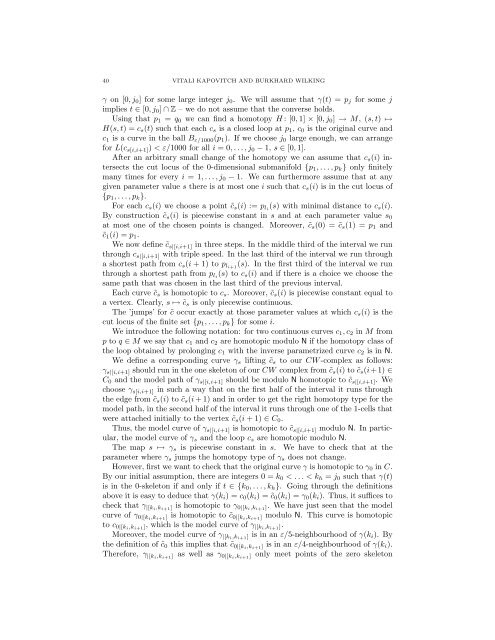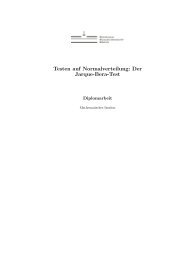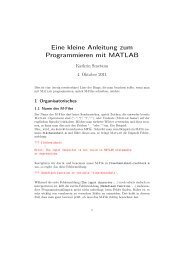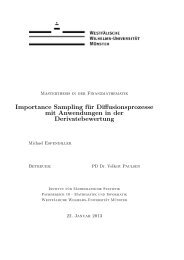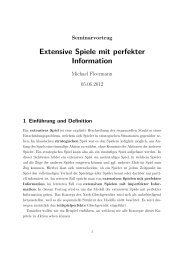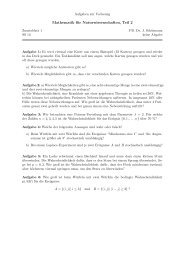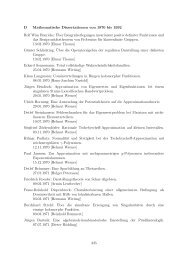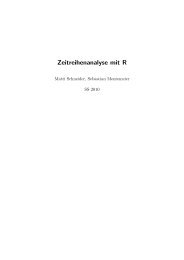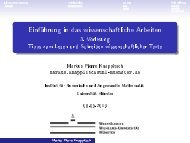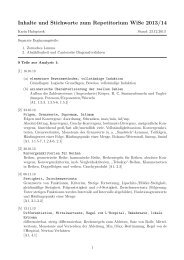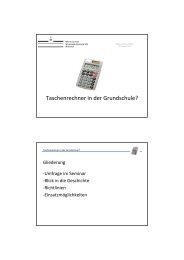Margulis Lemma
Margulis Lemma
Margulis Lemma
Create successful ePaper yourself
Turn your PDF publications into a flip-book with our unique Google optimized e-Paper software.
40 VITALI KAPOVITCH AND BURKHARD WILKING<br />
γ on [0, j 0 ] for some large integer j 0 . We will assume that γ(t) = p j for some j<br />
implies t ∈ [0, j 0 ] ∩ Z – we do not assume that the converse holds.<br />
Using that p 1 = q 0 we can find a homotopy H : [0, 1] × [0, j 0 ] → M, (s, t) ↦→<br />
H(s, t) = c s (t) such that each c s is a closed loop at p 1 , c 0 is the original curve and<br />
c 1 is a curve in the ball B ε/1000 (p 1 ). If we choose j 0 large enough, we can arrange<br />
for L(c s[i,i+1] ) < ε/1000 for all i = 0, . . . , j 0 − 1, s ∈ [0, 1].<br />
After an arbitrary small change of the homotopy we can assume that c s (i) intersects<br />
the cut locus of the 0-dimensional submanifold {p 1 , . . . , p k } only finitely<br />
many times for every i = 1, . . . , j 0 − 1. We can furthermore assume that at any<br />
given parameter value s there is at most one i such that c s (i) is in the cut locus of<br />
{p 1 , . . . , p k }.<br />
For each c s (i) we choose a point ˜c s (i) := p li (s) with minimal distance to c s (i).<br />
By construction ˜c s (i) is piecewise constant in s and at each parameter value s 0<br />
at most one of the chosen points is changed. Moreover, ˜c s (0) = ˜c s (1) = p 1 and<br />
˜c 1 (i) = p 1 .<br />
We now define ˜c s|[i,i+1] in three steps. In the middle third of the interval we run<br />
through c s|[i,i+1] with triple speed. In the last third of the interval we run through<br />
a shortest path from c s (i + 1) to p li+1 (s). In the first third of the interval we run<br />
through a shortest path from p li (s) to c s (i) and if there is a choice we choose the<br />
same path that was chosen in the last third of the previous interval.<br />
Each curve ˜c s is homotopic to c s . Moreover, ˜c s (i) is piecewise constant equal to<br />
a vertex. Clearly, s ↦→ ˜c s is only piecewise continuous.<br />
The ’jumps’ for ˜c occur exactly at those parameter values at which c s (i) is the<br />
cut locus of the finite set {p 1 , . . . , p k } for some i.<br />
We introduce the following notation: for two continuous curves c 1 , c 2 in M from<br />
p to q ∈ M we say that c 1 and c 2 are homotopic modulo N if the homotopy class of<br />
the loop obtained by prolonging c 1 with the inverse parametrized curve c 2 is in N.<br />
We define a corresponding curve γ s lifting ˜c s to our CW -complex as follows:<br />
γ s|[i,i+1] should run in the one skeleton of our CW complex from ˜c s (i) to ˜c s (i+1) ∈<br />
C 0 and the model path of γ s|[i,i+1] should be modulo N homotopic to ˜c s|[i,i+1] . We<br />
choose γ s[i,i+1] in such a way that on the first half of the interval it runs through<br />
the edge from ˜c s (i) to ˜c s (i + 1) and in order to get the right homotopy type for the<br />
model path, in the second half of the interval it runs through one of the 1-cells that<br />
were attached initially to the vertex ˜c s (i + 1) ∈ C 0 .<br />
Thus, the model curve of γ s|[i,i+1] is homotopic to ˜c s|[i,i+1] modulo N. In particular,<br />
the model curve of γ s and the loop c s are homotopic modulo N.<br />
The map s ↦→ γ s is piecewise constant in s. We have to check that at the<br />
parameter where γ s jumps the homotopy type of γ s does not change.<br />
However, first we want to check that the original curve γ is homotopic to γ 0 in C.<br />
By our initial assumption, there are integers 0 = k 0 < . . . < k h = j 0 such that γ(t)<br />
is in the 0-skeleton if and only if t ∈ {k 0 , . . . , k h }. Going through the definitions<br />
above it is easy to deduce that γ(k i ) = c 0 (k i ) = ˜c 0 (k i ) = γ 0 (k i ). Thus, it suffices to<br />
check that γ |[ki,k i+1] is homotopic to γ 0|[ki,k i+1]. We have just seen that the model<br />
curve of γ 0|[ki,k i+1] is homotopic to ˜c 0|[ki,k i+1] modulo N. This curve is homotopic<br />
to c 0|[ki,k i+1], which is the model curve of γ |[ki,k i+1].<br />
Moreover, the model curve of γ |[ki,k i+1] is in an ε/5-neighbourhood of γ(k i ). By<br />
the definition of ˜c 0 this implies that ˜c 0|[ki,k i+1] is in an ε/4-neighbourhood of γ(k i ).<br />
Therefore, γ |[ki,k i+1] as well as γ 0|[ki,k i+1] only meet points of the zero skeleton


